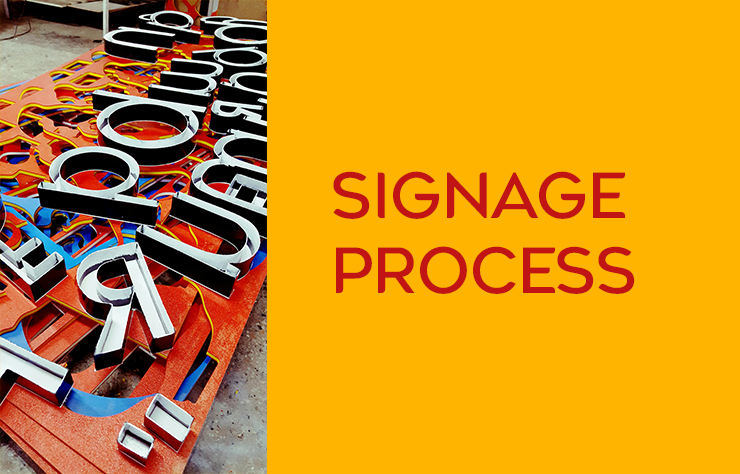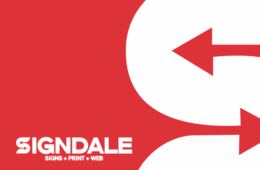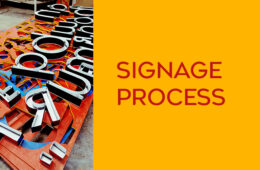 March 11, 2023
March 11, 2023
Creating custom business signage is more complex than you might think. The process can span days, weeks, or even months, whether you’re looking for indoor or outdoor signs. However, understanding the signage process and collaborating with a knowledgeable partner can make all the difference.
A successful signage project requires careful planning and execution. To ensure your signs are attractive, visible, and captivating, it’s essential to follow each step of the process. This includes strategy development, design and production, permit acquisition, proofreading, and professional installation. Continuous communication with your hometown signage partner is also crucial to guarantee project success.
By investing time and effort into the signage process, you’ll be rewarded with high-quality business signs that effectively promote your brand. If you’re reopening your business, now’s the perfect time to invest in new signage. Partner with a trusted expert to guide you through the process and elevate your business’s visual identity. With quality signage, you’ll be well on your way to attracting customers and driving business growth.
The Signage Process
Here are the key steps of the signage process:
Build a Comprehensive Plan
Kickstart your signage project by building a comprehensive plan with your provider, covering essential factors such as branding, requirements, deadlines, design, pricing, installation, and permits to ensure a well-executed strategy.
- Branding
- Signage requirements
- Project deadline
- Signage designs
- Prices and quotations
- Installation details
- Critical licenses and permits
In today’s remote business landscape, initiating a phone or video call with your signage partner is crucial for clear communication and project clarity. Schedule a virtual meeting to discuss project details and ensure you document all key discussion points, decisions, and action items to prevent misunderstandings and guarantee a seamless project execution.
Discuss Design and Development
With the initial discussion complete, progress to the design and development phase of your signage project. Collaborate with your signage partner’s in-house designers or share your own design concepts to carefully plan the visual appearance of your business signs. Key design elements to discuss include:
- Company branding
- Corporate colors
- Company logo
- Company font
- Dimensions of the signs
- Shape of the sign
- Material
- Layout
- Type of sign
- Content
- Call-to-action
Allocate sufficient time for design and development discussions with your signage partner, typically requiring 2-3 sessions. Resist the urge to rush this critical stage, as thorough collaboration now prevents last-minute design revisions, ensures accuracy, and yields a well-crafted visual representation of your brand.
Apply for the Necessary Permits
Business signs are subject to various laws and guidelines, which vary by state and locality. While exceptions exist, such as cities exempting window graphics from licensing requirements, it’s crucial to understand the specific regulations governing your business signage.
To avoid last-minute issues, secure necessary permits before developing your signs. Follow these steps:
- Complete permit forms
- Request landowner consent (if applicable)
- Submit zoning certification
- Apply for permit approval (typically taking 2-4 weeks)
A permit application can take up to four weeks to get approved if everything is in order. You can also request your signage partner to help you with the permit.
Proofread the Signs Before Production
Before proceeding to production, meticulously review your signs by requesting a mockup or prototype. Conduct a thorough proofread to detect and correct any:
- Errors in spelling, grammar, or punctuation
- Color inconsistencies or clashes
- Layout issues or improper alignment
- Inaccurate logo or branding representation
- Pixelation or low-resolution images
- Incorrect contact information or messaging
Get Ready for Installation
When your signs are ready, entrust their installation to professionals. Avoid DIY installation, as it can compromise the sign’s durability, safety, and visual impact. Instead, consider hiring your signage partner to handle installation, ensuring:
- Secure and level mounting
- Proper electrical connections (if applicable)
- Compliance with local regulations
- Minimized risk of damage or injury
- A polished, professional finish
Additional Key Considerations to Discuss with Your Signage Partner:
Apart from the five steps discussed above, here are some other critical points that you need to discuss with your signage partner:
Project Duration and Deadline
When discussing the timeline of your signage project, you need to keep in mind the proofreading stage. The development can only begin once you’ve approved the mockups. Avoid rushing and take time to finalize the designs. The project duration will typically depend on the following factors:
- Number of signs
- Size of the sig
- Material used
- Type of sign
- Complexity of the sign design
- Number of design iterations
- Printing technique
Payment Plan
You can discuss and finalize the payment plan with your signage partner. Most signage providers prefer receiving some payment upfront. You can pay the remaining portion when they complete your signage project. The payment plan will typically depend on the following factors:
- Total amount
- Mode of payment
- Project timeline





